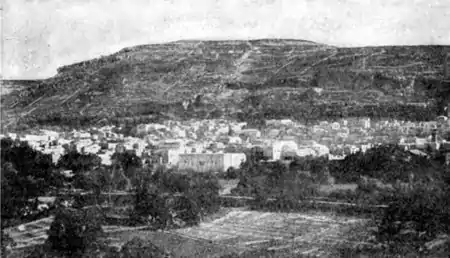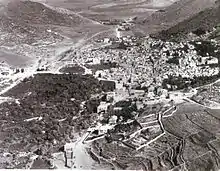List of World Heritage Sites in the State of Palestine
The United Nations Educational, Scientific and Cultural Organization (UNESCO) World Heritage Sites are places of importance to cultural or natural heritage as described in the UNESCO World Heritage Convention, established in 1972.[1] Cultural heritage consists of monuments (such as architectural works, monumental sculptures, or inscriptions), groups of buildings, and sites (including archaeological sites). Natural heritage is defined as physical and biological formations, geological and physiographical formations (including habitats of threatened flora and fauna), and sites which are important from the point of view of scientific research, conservation or natural aesthetic.[2]

The State of Palestine accepted the convention on 8 December 2011, making its cultural and natural heritage sites eligible for inclusion on the list. As of 2023, there are four World Heritage Sites in Palestine, all of which are located at the West Bank territory: the Church of the Nativity as the Birthplace of Jesus and associated Pilgrimage Route in Bethlehem; Hebron's old town; Battir's Land of Olives and Vines as a Cultural Landscape of Southern Jerusalem; and Tell es-Sultan in ancient Jericho.[3] Two are on UNESCO's List of World Heritage in Danger.[4][5] The Birthplace of Jesus site was once on the list from 2012 to 2019.[6] In addition, the Palestinian government has put 13 sites on its tentative list, meaning they intend to nominate them as World Heritage Sites sometime in the future.[3]
The Hashemite Kingdom of Jordan proposed the Old City of Jerusalem and its Walls, located in East Jerusalem, to be listed as a World Heritage Site. The site is not assigned to a state on the UNESCO listing,[7] with respect to its disputed status on whether it belongs to the State of Israel or Palestine. In 2011 UNESCO stated that it "continues to work to ensure respect for the outstanding universal value of the cultural heritage of the Old City of Jerusalem. [..] In line with relevant UN resolutions, East Jerusalem remains part of the occupied Palestinian territory, and the status of Jerusalem must be resolved in permanent status negotiations."[8]
Due to the conflict between the two countries, Israel has been a vocal critic of Palestine's position in UNESCO since its plans to enter, and left the convention in 2019 with the United States, accusing it of being dismissive of their heritage. Tell-es-Sultan's inclusion as a Palestinian site was criticized by its Foreign Ministry as "another sign of Palestinians' cynical use of UNESCO and politicization of the organization" and wishes to revert the "distorted decisions".[9] Meanwhile, Palestine's Minister of Agriculture Riad Attari deemed the inclusion as a step toward their right to return.[10] Experts argued that the Israeli cabinet is the one politicizing UNESCO, with Israeli heritage organization Emek Shaveh noting that the part of Jericho claimed by Israel is not the one listed.[11] Prior to their leave, Israel has made gradual cuts in funding for the UNESCO in dismay towards the progression of Palestine's World Heritage List.[12]
World Heritage Sites
UNESCO lists sites under ten criteria; each entry must meet at least one of the criteria. Criteria i through vi are cultural, and vii through x are natural.[13]
| Site | Image | Governorate | UNESCO data | Year listed | Description |
|---|---|---|---|---|---|
| Birthplace of Jesus: Church of the Nativity and the Pilgrimage Route, Bethlehem |  |
Bethlehem Governorate | 1433; Cultural: (iv)(vi) |
2012 | Located 10 kilometres (6.2 miles) away from Jerusalem, Chrstianity widely regards a cave in Bethlehem as where Jesus was born. The nearby Church of the Nativity is the oldest regularly-used Christian church and has gained notoriety as a pilgrimage site. In the Early Middle Ages, many churches were built around the Nativity, with Latin, Greek, Fransiscan, and Armenian architectural styles. The main route from Jerusalem to Bethlehem which also extends to the Damascus Gate is seen as the path Jesus' parents Joseph and Mary used.[14] UNESCO immediately listed it as a World Heritage in Danger due to the church's poor condition, but removed it in 2019 with the extensive restoration done to its exterior.[6] |
| Hebron/Al-Khalil Old Town† |  |
Hebron Governorate | 1565; Cultural: (ii)(iv)(vi) |
2017 | This town was established amid the Mamluk Sultanate (1250-1517) at an area known for its limestone. A pilgrimage site for Judaism, Christianity, and Islam, Hebron's landmark is the Cave of the Patriarchs, where Abraham and his family were allegedly buried. Once a trading hub for the nearby countries, it was expanded during the country's rule under the Ottoman Empire, although the Mamluk architecture persists.[15] The site was immediately listed as endangered due to constant vandalism and damage.[12] |
| Palestine: Land of Olives and Vines – Cultural Landscape of Southern Jerusalem, Battir† |  |
Bethlehem Governorate | 1492; Cultural: (iv)(v) |
2014 | Located between Hebron and Nablus, Battir's residents utilise the area's valleys and terraces for market garden, as well as farming grapevines and olive trees. Because of its mountainous location, underground irrigation channels were made to accommodate farmers, and an egalitarian distribution system is used to send its immense supply of water. The cultural landscape also comprises rock-cut tombs and watchtowers.[16] The impact of the Israeli-Palestinian conflict, exemplarily taking form in a border wall, may lead to a loss of heritage; thus it was immediately listed endangered.[17] |
| Ancient Jericho/Tell es-Sultan |  |
Jericho Governorate | 1687; Cultural: (i)(ii)(iii)(iv) |
2023 | This site comprises a tell dating back to at least 10,500 BC, as well as the nearby village of Ein as-Sultan. During the 9th to 8th millenium BC (Neolithic), humans began permanently settling here due to the soils' fertility and accessible water supply. Various architectural works were made; surviving ones include a ha-ha and tower. The Bronze Age saw urban planning and the establishment of a Canaanite city-state. Unlike the other Palestinian sites, UNESCO did not list Tell-es-Sultan as endangered.[18] |
World Heritage Sites located in East Jerusalem
| Site | Image | Governorate | UNESCO data | Year listed | Description |
|---|---|---|---|---|---|
| Old City and Walls of Jerusalem† | -Temple_Mount-Reflection_of_the_Dome_of_the_Rock_in_Al-Kas_fountain.jpg.webp) |
Jerusalem Governorate | 148rev; Cultural: (ii), (iii), (vi) |
1981 | Jerusalem is a holy city for the three Abrahamic religions: Christianity, Islam, and Judaism, with one of its landmark, the 7th-century Dome of the Rock, recognised by all three as where Abraham was sacrificed. "Walls" refers to the Western Wall, also another worship landmark. UNESCO also mentions the Church of the Holy Sepulchre, whose rotunda is believed to be Jesus' burial site.[19] Jerusalem has been endangered since 1982 due to persistent illegal damages by Israel.[20] |
Tentative list
In addition to sites inscribed on the World Heritage List, member states can maintain a list of tentative sites that they may consider for nomination. Nominations for the World Heritage List are only accepted if the site was previously listed on the tentative list.[21] As of 2023, Palestine recorded 13 sites on its tentative list. The sites, along with the year they were included on the tentative list are:[22]
| Site | Image | Location | Criteria | Year |
|---|---|---|---|---|
| Hisham's Palace / Khirbet al-Mafjar |  |
Jericho Governorate | Cultural: (i)(ii) |
2020 |
| Mount Gerizim and the Samaritans |  |
Nablus Governorate | Cultural: (iii)(vi) |
2012 |
| Qumran Caves and Monastery of the Dead Sea Scrolls |  |
Jericho Governorate | Cultural: (iii)(iv)(vi) |
2012 |
| El-Bariyah: Wilderness with Monasteries |  |
Judaean Desert, Mount of Temptation | Cultural: (i)(ii)(iii) |
2012 |
| Wadi Natuf and Shuqba cave |  |
Ramallah and al-Bireh Governorate | Cultural: (ii)(iii)(iv) |
2013 |
| Old Town of Nablus and its environs |  |
Nablus Governorate | Cultural: (ii)(iv) |
2012 |
| Tell Umm Amer | Gaza Strip | Cultural: (ii)(iii)(vi) |
2012 | |
| Throne Villages | Ibwein, Arrabeh, Beit Wazan, Burqa, Deir Ghassaneh, Deir Istia, Dura, Jamma'in, Kur, Nelean, Ras Karkar, Sebastia and Sanur | Cultural: (iii)(iv) |
2013 | |
| Sebastia |  |
Nablus Governorate | Cultural: (ii)(v) |
2012 |
| Anthedon Harbour | Gaza Strip | Cultural: (ii)(iv) |
2012 | |
| Umm Al-Rihan forest | Jenin Governorate | Natural: (x) |
2012 | |
| Wadi Gaza Coastal Wetlands | Gaza Strip | Natural: (x) |
2012 | |
| Baptism Site “Eshria’a” (Al-Maghtas) |  |
Jericho Governorate | Cultural: (iii)(iv)(vi) |
2015 |
See also
References
- "The World Heritage Convention". UNESCO World Heritage Centre. Archived from the original on 27 August 2016. Retrieved 21 September 2010.
- "Convention Concerning the Protection of the World Cultural and Natural Heritage". UNESCO World Heritage Centre. Archived from the original on 1 February 2021. Retrieved 3 February 2021.
- "Palestine". UNESCO. Retrieved 8 July 2019.
- "Palestine: Land of Olives and Vines – Cultural Landscape of Southern Jerusalem, Battir - Indicators". UNESCO. Retrieved 14 July 2017.
- "Hebron/Al-Khalil Old Town - Indicators". UNESCO. Retrieved 14 July 2017.
- "The site of the Birthplace of Jesus in Bethlehem (Palestine) removed from the List of World Heritage in Danger". UNESCO. Retrieved 7 July 2019.
- "Old City of Jerusalem and its Walls", UNESCO World Heritage List website, accessed 13 November 2017.
- UNESCO press release, 15 July 2011, accessed 13 November 2017.
- AP and ToI Staff. "UNESCO votes to list ruins near ancient Jericho as a World Heritage Site in Palestine". www.timesofisrael.com. Retrieved 19 October 2023.
- "Palestine Applauds Decision to Inscribe 'Tell es-Sultan' on World Heritage List". english.aawsat.com. Retrieved 19 October 2023.
- "Unesco's addition of West Bank archaeological site to World Heritage list fans Israel-Palestine tensions". The Art Newspaper - International art news and events. 19 September 2023. Retrieved 19 October 2023.
- "UNESCO puts Hebron on its danger list – DW – 07/07/2017". dw.com. Retrieved 20 October 2023.
- "UNESCO World Heritage Centre The Criteria for Selection". UNESCO World Heritage Centre. Archived from the original on 12 June 2016. Retrieved 17 August 2018.
- "Birthplace of Jesus: Church of the Nativity and the Pilgrimage Route, Bethlehem". UNESCO. Retrieved 14 July 2017.
- "Hebron/Al-Khalil Old Town". UNESCO. Retrieved 14 July 2017.
- "Palestine: Land of Olives and Vines – Cultural Landscape of Southern Jerusalem, Battir". UNESCO. Retrieved 13 November 2017.
- Centre, UNESCO World Heritage. "Palestine: Land of Olives and Vines - Cultural Landscape of Southern Jerusalem, Battir, inscribed on World Heritage List and on List of World Heritage in Danger". UNESCO World Heritage Centre. Retrieved 20 October 2023.
- Centre, UNESCO World Heritage. "Ancient Jericho/Tell es-Sultan". UNESCO World Heritage Centre. Retrieved 24 September 2023.
- "Old City of Jerusalem and its Walls". UNESCO. Retrieved 26 November 2012.
- Centre, UNESCO World Heritage. "UNESCO World Heritage Centre - State of Conservation (SOC 2023) Old City of Jerusalem and its Walls (Jerusalem (Site proposed by Jordan))". UNESCO World Heritage Centre. Retrieved 25 October 2023.
- "Tentative Lists". UNESCO. Retrieved 12 July 2014.
- Centre, UNESCO World Heritage. "UNESCO World Heritage Centre - Tentative Lists". UNESCO World Heritage Centre.
